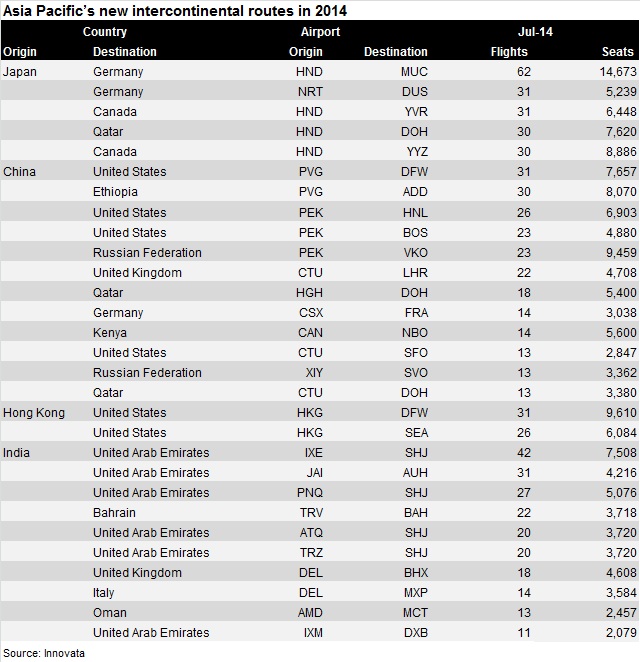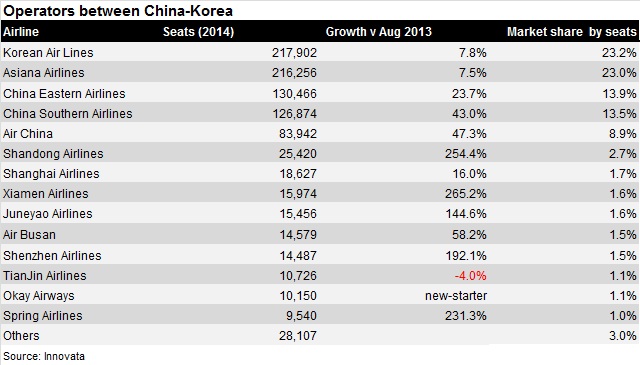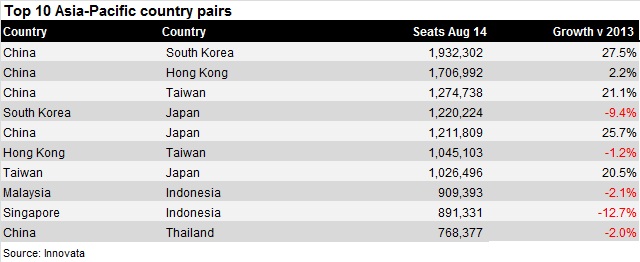Joanna Lu, Hong Kong-based analyst from Flightglobal consultancy Ascend, considers the changing market dynamics driving the extra capacity in the Asia-Pacific sector.
Low-cost carriers are helping to drive increased traffic flows between North and Southeast Asia even as the dynamics behind the region's continued fast growth are shifting.
Asia-Pacific airlines, along with Latin America and Middle East airlines, have led passenger traffic growth over the last five years. But while growth is expected to continue this year, a recent study by Flightglobal consultancy Ascend indicates that there are major changes afoot in Asia-Pacific's market dynamics.
While North Asia shows momentum in connecting Asia-Pacific with other continents, connectivity is also increasing between the Southeast Asian market and the North. This in turn has impacted the airport sector, making it the right time for both airlines and airports in Asia-Pacific to explore new opportunities.
INTERCONTINENTAL: NORTH ASIA DRIVES MARKET
In July 2014, the total flights on intercontinental routes to and from the Asia-Pacific increased by 3.5% and by 4.3% in terms of available seats. The growth was highlighted by those already-busy routes between key hubs in North Asia and Europe, USA and the Middle East, where more than five daily one-way routes are operated.
China, India and Japan continue to grow new intercontinental routes the fastest. Tokyo Haneda has benefited from the increased international slots and handled nearly 2,500 outbound flights overseas in July 2014. This is an increase of 47.5% year on year. This has included some foreign carriers that have shifted their capacity from Tokyo's Narita airport to Haneda to leverage domestic traffic volumes at the latter.
China’s secondary airports, such as Chengdu, Hangzhou, Changsha and Xi’an kept up quickly this year and showed great ambition in expanding their networks to Europe and the USA.
India’s connections to the United Arab Emirates has solidified after the two countries reached a new bilateral agreement in April last year, helping to fuel increased co-operation – notably Etihad's tie-up with Jet Airways – between airlines from the two countries. This year will see another 12,800 weekly seats added to the market and a further 12,870 will follow next year.
Capacity between Dubai and Asia was affected by Emirates’ temporary flight cutback due to runway construction in Dubai. In effectively utilising the reduced capacity, Emirates shifted some services in Southeast Asia to North Asia during the construction period.

REGIONAL: RESHAPING THE GROWTH
This year, the China-South Korea route moved ahead of China-Hong Kong as the largest country pair in the Asia-Pacific market by seat capacity. This represents growth of 27.5% in the total number of seats between the two countries compared with the same time last year.
The market share by the two countries’ operators are comparable, but while Asiana Airlines and Korean Air Lines dominated the services from South Korea, it was more fragmented among their Chinese counterparts. The three major Chinese flag carriers have experienced huge growth in expanding to the South Korean market, where China Southern and Air China lifted nearly 50% of their capacity on this market. Beijing, Shanghai, Guangzhou and secondary markets on the northeast coast of China, such as Qingdao, Yantai, Tianjin, Dalian, all benefited from the extra capacity.

There was significant growth on the China-Taiwan, China-Japan and Taiwan-Japan routes, where total seats increased more than a fifth over the last year. Singapore cut its connections to major markets in Southeast Asia such as Indonesia (-12.7%), Malaysia (-7.7%), Thailand (-6.3%) while raising capacity to Hong Kong (10.9%), Japan (9.8%) and Vietnam (12.6%), indicating its intention of increasing connections to North Asia.

One of the key drivers of Asia-Pacific’s recent route development changes has been the LCCs shifting capacities from within Southeast Asia to North Asia. As the region's large LCCs originated in Southeast Asia, they have, to some extent, secured their presence in domestic and short-haul markets. Stepping up their operations in the international market and flying longer routes is a logical next step.
While AirAsia has cut capacity on Malaysian domestic routes and flights to Singapore, it has increased capacity dramatically to Indonesia, Thailand, Cambodia, Vietnam and China.
Jetstar Asia showed its ambition in North Asia through double-digit capacity growth on services to Hangzhou, Shantou and Taipei. The airline has also quickly added capacity to Cambodia, Myanmar and Thailand. However, Jetstar Asia cut 30% of its seat capacity on the Singapore-Kuala Lumpur route in 2014 due to the high frequency provided on that market. Tigerair typically launched many new routes to China, India, Myanmar and Vietnam by cutting capacities provided in Southeast Asia market.
AIRPORTS: CHANGING MARKET FOCUS
The shifting route development dynamics have had a major impact on airport development in the region. Bangkok’s Don Mueang is one of the beneficiaries. The number of outbound seats from Don Mueang tripled in 2013 compared with 2012 when the airport was reopened. In 2013, the airport had 16.5 million passengers and this is expected to have risen by another 20% in the first half of this year.
Dramatic changes took place on routes between Bangkok and Singapore, with capacity dropping by a fifth on flights between Bangkok Suvarnabhumi and Singapore, but rising nearly 30% from Singapore to Don Mueang in July 2014. While congestion and infrastructure problems at Suvarnabhumi airport created an opportunity for Don Mueang, it is still business demands that are driving airlines' motivation for relocating to Don Mueang airport because of the easier access.
LCCs or smaller operators also have more flexibility in relocation as a result of their smaller operational scale. Analysis shows key LCCs increasingly tend to explore new markets in Asia, especially China, South Korea, Myanmar, Vietnam and Cambodia.
It is foreseeable that Don Mueang may have better coverage from its network perspective. When a city or region’s traffic is achieving a level that a single airport is not able to serve, a multiple airports solution has to be put in place. Only then will there be opportunities for the new/secondary airport to leverage the overflow demand. The important work to do is to position the airport’s role in the region and their target airlines. Infrastructure has to be the preliminary requirement to leverage the opportunities ahead. Don Mueang has a potential of 30 million passenger capacity and can probably be expanded further. Thus, it has a good starting point.
There are some other airports with outstanding traffic performance this year which are mainly driven by proactive air marketing strategies and the introduction of new routes. China’s Chengdu is a good example, after it launched 11 new international routes with access to the key hubs in Europe, USA and Asia.
This will dramatically impact customer choices on departing and arriving in central China. It will be interesting to see how this has impacted the hub competition picture in China, and for hubs close to Chengdu's catchment area, the airport is an important one to watch.
Source: Cirium Dashboard























